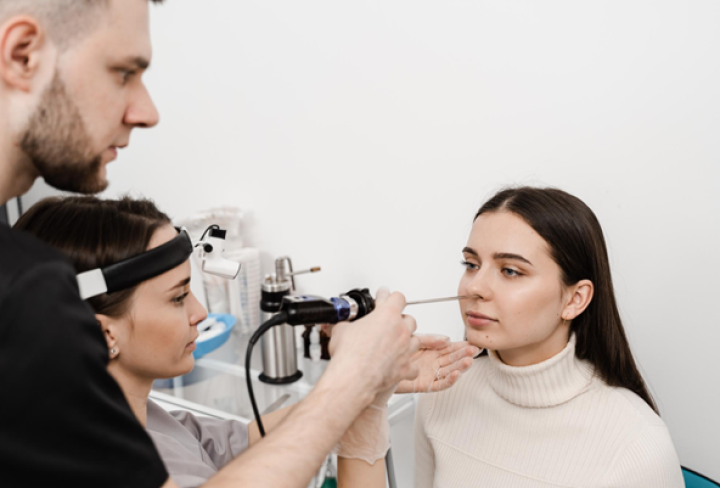Rhinoscopy is a medical procedure that looks into your nose to find out what might be wrong. It’s quite handy for doctors to figure out certain problems early on. By understanding this procedure, you can be prepared if a doctor suggests it. The goal here is to explain what rhinoscopy is all about, why it’s used, and what you can expect during the process. Knowing more about rhinoscopy can help you feel more at ease if you ever need it.
What is Rhinoscopy?
Rhinoscopy is a method doctors use to peer inside your nose. It helps them spot any issues in there. It’s essential for finding out what might be causing things like blockages or discomfort. Rhinoscopy can be done in two ways:
- Anterior Rhinoscopy: The doctor looks from the front of your nose.
- Posterior Rhinoscopy: They look from the back.
In these procedures, they use special tools. A nasal speculum helps to gently widen your nostrils so the doctor can see better. An endoscope, a tiny camera on a tube, is also used to view your nasal cavity. Additionally, a post-nasal mirror may assist in examining the deeper parts. These tools are crucial for accurate diagnostic rhinoscopy.
How is the Rhinoscopy Procedure Conducted?
Let’s break down how the rhinoscopy procedure happens step by step:
- Anterior Rhinoscopy: First, the doctor uses a nasal speculum to open your nostrils. This makes it easier to see the inside structures of your nose. They look at your nasal passages and any visible tissues.
- Posterior Rhinoscopy: For this, they might use a mirror to see behind your nose or use an endoscope for clearer images of the area.
During both types of rhinoscopy, you might get some local anesthesia. It helps numb the area to keep you comfortable. You will usually sit up straight or lean your head back so the doctor can see clearly. Patients often feel minimal discomfort, like a tickling sensation, during nasal rhinoscopy.
Understanding What Rhinoscopy Reveals
Rhinoscopy shows a lot about what’s going on in your nose:
- Anterior Rhinoscopy: This can reveal how healthy your nasal lining is, the presence of nasal polyps, or if there are any foreign objects inside.
- Posterior Rhinoscopy: It helps in checking the bump or curve of the septum, the appearance of the turbinates, or how the eustachian tubes look.
These views are important for spotting potential issues early.
Conditions Diagnosed Through Rhinoscopy
Many conditions can be diagnosed with rhinoscopy:
- It can find nasal polyps, which are small, non-cancerous swellings inside the nose.
- Problems like sinusitis or infections and even nasal tumors can be identified.
- If you have frequent nosebleeds, it helps spot where they’re coming from.
- For people dealing with obstructive sleep apnea, rhinoscopy for sinusitis can be useful to pinpoint blockages.
- It’s also helpful for finding and removing foreign objects from the nose.
Early diagnosis through rhinoscopy can lead to quicker treatment, preventing more serious issues later on.
Indicators for When Rhinoscopy is Needed
Here are some signs that you might need a rhinoscopy:
- You have long-term nasal stuffiness that doesn’t go away.
- There are frequent or unexplained nosebleeds.
- If there’s nasal blockage or you’re having trouble speaking clearly, nasal rhinoscopy might be recommended.
Seeing a doctor early can help in addressing these issues effectively.
Benefits and Safety of the Rhinoscopy Procedure
The rhinoscopy procedure offers several perks:
- It’s precise, letting doctors spot problems accurately.
- This procedure is non-invasive, meaning it doesn’t require big cuts or operations.
- Sometimes, treatments can even be done during the procedure.
Fear of rhinoscopy is common, but misconceptions fuel it. It’s not painful; most people feel just a little odd during it. Procedures are safe, with necessary precautions taken. If worried, discuss it with your doctor.
Preparation and Aftercare for Rhinoscopy
Before your rhinoscopy, your doctor will give some instructions:
- Avoid eating or drinking anything right before the procedure.
- Follow any specific advice your doctor gives, like avoiding certain medications.
After the rhinoscopy, you might feel some mild discomfort or a little nosebleed. Use a soft tissue and do not blow your nose too hard. Follow your doctor’s advice, which might include scheduling a follow-up appointment.
Conclusion: Emphasizing the Importance of Rhinoscopy
We’ve covered what rhinoscopy is, why it’s done, and what it addresses. It’s a minor procedure with major potential to help your doctor diagnose problems affectively. If you experience nasal issues or persistent symptoms, consider reaching out to an ENT specialist. Diagnostic rhinoscopy can be a vital step toward better nasal health, and it’s always best to address concerns promptly. Remember, the knowledge of rhinoscopy for sinusitis and related issues can empower you in taking charge of your health. Stay informed and healthy!



